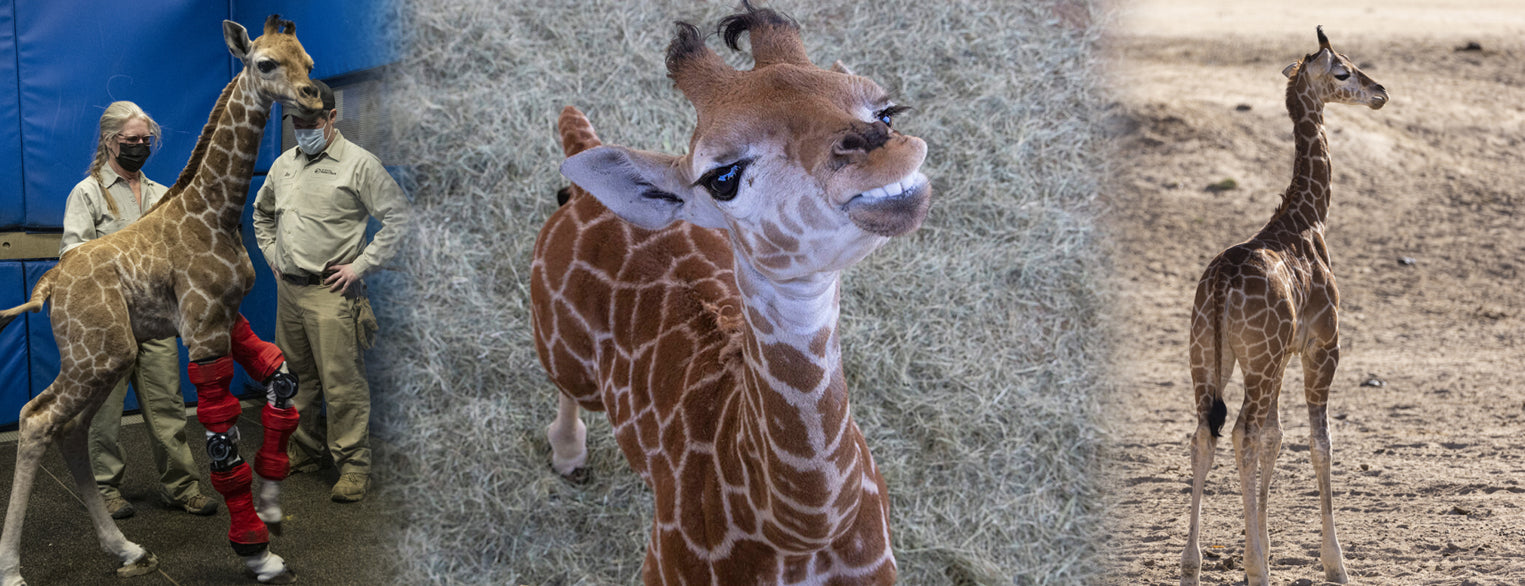Shop All
ADULTS
KIDS
TOYS & BOOKS
FOR THE HOME
ADULTS
KIDS
TOYS & BOOKS
FOR THE HOME
ICONIC & ECO-FRIENDLY
Wildlife
Deals
Msituni the Giraffe Calf Is Up and Running
March 24, 2023 4 min read

Msituni the Giraffe Calf Is Up and Running
A baby giraffe, called a calf, can stand up and walk about an hour after it comes into the world, front feet first. At least, it should be able to. That wasn’t the case with Msituni (see-TOO-nee), a giraffe born at the Safari Park February 1, 2022. Matt Kinney, DVM, senior veterinarian at the San Diego Zoo Safari Park, and his team were quick to respond. “Our wildlife care specialists and veterinary team have worked with a number of giraffe calves, and we were quickly able to recognize that this calf needed our help,” he said.
Lauren Howard, DVM, is director of veterinary services at the Safari Park. “The day Msituni was born, we saw that one of her front legs was unstable, making it difficult for her to stand and walk,” Dr. Howard said. “She wasn’t able to keep up with her mom and the herd.” That in itself is a serious situation for a giraffe calf, which must be able to stand to suckle from its mother, and to follow her across the African savanna.
In Msituni’s case, her front legs were bending improperly. The very day she was born, Dr. Howard and Dr. Kinney quickly realized that Msituni would need significant medical intervention. “Our immediate actions for Msituni were aimed to minimize long-term joint damage, and do our best to ensure she has a long, healthy life free of future joint disease and arthritis,” she said. “This required pretty extreme action initially, including electing to bottle raise her because her injuries prevented her from staying with her mom. It was a tough decision, and it was the right one for her long-term health.”
At SDZWA’s Paul Harter Veterinary Medical Clinic, detailed 3D imaging of Msituni’s legs provided further information. The care team determined that specialized hoof extenders should be able to fix the irregular position of Msituni’s back legs, but the next question was where to find specialized giraffe orthotics. It goes without saying—that was no easy task. “Her size made finding flexible, but strong, supports for her legs very challenging,” said Dr. Howard.
The solution came in partnership with Hanger Clinic, a nationwide provider of outcomes-based orthotic and prosthetic (O&P) care. While the company focuses on care for humans, members of the San Diego-based Hanger Clinic team consulted with Safari Park wildlife care staff. Together, they got moldings of Msituni’s legs so they could craft custom hinged orthotic braces for the calf. “There was a lot of science behind the brace manufacturing, but also a significant amount of art and creativity needed to make sure it was applied and adjusted appropriately to make sure Msituni could lay down, stand, walk, and run like a healthy giraffe,” said Dr. Kinney.
Ultimately, the treatments were a success. After about two months, with her legs correctly positioned, caregivers were able to remove her leg braces. Today, Msituni can be found frolicking with the rest of the giraffe herd in the Safari Park’s 60-acre East Africa savanna habitat, including another female calf named Nuru, born just four days after Msituni.
There were numerous challenges along the way to Msituni’s recovery. “Caring for Msituni involved numerous individuals and departments within SDZWA and established a relationship with some amazing individuals at the Hanger company that designed and manufactured the brace,” said Dr. Kinney. “This case is an excellent example of the value of collaboration and alliance. To address the complex challenges that face wildlife, we need to work together, and this case exemplifies that need.”
Dr. Howard agrees. “It was rewarding to use our veterinary expertise and problem-solving skills to reverse what could have easily been a fatal condition,” she says. “Meeting new colleagues at Hanger and working through the technical challenges with that great group of people was key, too.”
“Our team often interacts with animals when they are the sickest and most vulnerable,” said Dr. Kinney. “Every time we see Msituni in the complex field habitat with other giraffes, we are reminded that our hard work in this case led to a successful outcome.” Both veterinarians are guided by SDZWA’s vision for the future—a world where all life thrives. “’Thrive’ means not just to survive, but also to live your best life,” says Dr. Howard.
Science teams have estimated that fewer than 100,000 giraffes are left in their native habitats—a decrease of more than 40 percent over the last 20 years. The downward trend is due to habitat loss and fragmentation, as well as poaching in certain regions. SDZWA partners with numerous conservation organizations on large-scale conservation projects, in an effort to slow and eventually stop the continued decline of giraffe populations.
Love these long necked land animals? Support our mission to care for wildlife like Msituni and her giraffe family near and far. Your purchase of giraffe tees, tanks, plush toys, books, and home décor has a positive impact on our organization's conservation efforts. We have a TALL order. Please be an ally in saving and protecting wildlife worldwide by shopping our giraffe collection here.
*As seen on San Diego Zoo Wildlife Alliance Stories.
Leave a comment
Comments will be approved before showing up.
Newsletter
Find out about our newest arrivals and get special offers in your inbox!

Be a Wildlife Ally
Discover a wild array of products at ShopZoo, where every purchase helps save, protect, and care for wildlife.
Find out about our newest arrivals and get special offers in your inbox!

